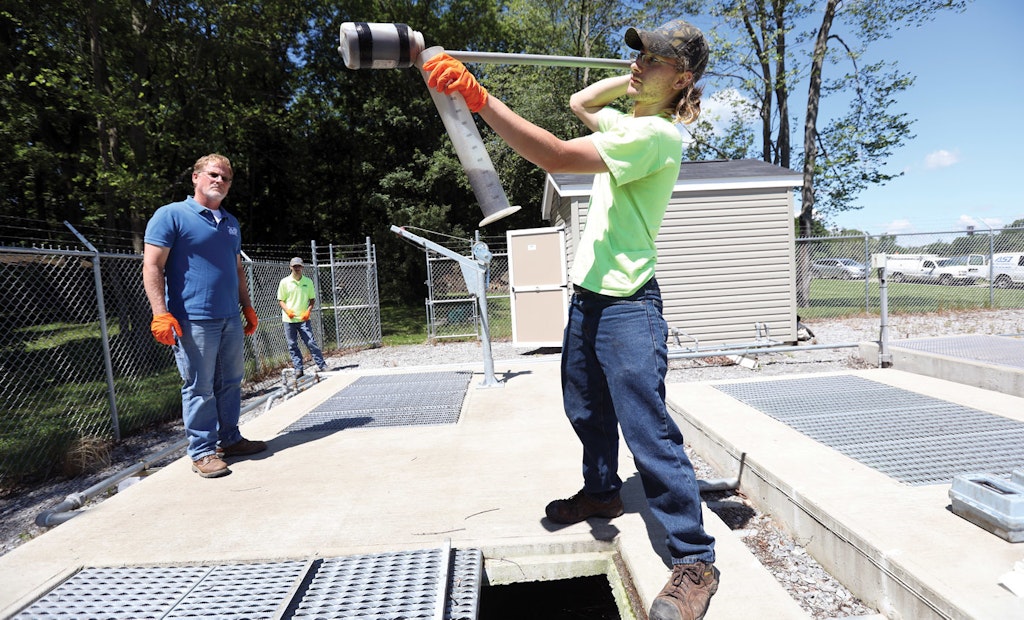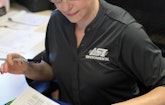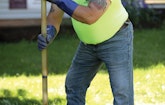
Jeremiah Rothwell takes water samples during an inspection of a lift station in Orrville, Ohio. Fred Rothwell, left, looks on. (Photos by Amy Voigt)
Aeration Septic Inc. (ASI) services some 2,500 contract customers with advanced onsite treatment systems in northeastern Ohio and performs a growing number of installations. That’s not nearly enough for owner and CEO Krista Gesaman and her 12 team members.
They’ve branched out into areas as diverse as installing wastewater lift stations for municipalities and selling onsite treatment products and other goods online. They’re looking to expand into stormwater management, and a growing line of business is maintaining larger decentralized systems for nursing homes, mobile home parks and other facilities that require a licensed operator. There’s no telling what will come next: If it’s related to water, ASI is interested.
“Water is the future,” says Gesaman, who has owned the business since 2012. “It’s a finite resource. Water is confronted with a lot of issues. I wanted to be in an environment with progressive-thinking people working on solutions for many of the water-based issues we see in our communities.”
GROWING WITH GUSTO
Gesaman came to the onsite business in a less-than-conventional way. After earning law degrees from Ohio Northern University in 2007 and American University Washington College of Law in 2010, she went to work in Washington, D.C., for a major corporation, dealing with issues around high-performance buildings and green building construction techniques. As part of that, she learned about the importance of water.
In 2011, she moved back to her roots in Ohio to be closer to family. She was still practicing law, but then learned that a business called Aeration Septic was for sale. At the time, it had a staff of three and a core business of about 500 onsite system maintenance contracts. She bought part of the business in 2012, partnering with owner Jeff Oyster, who founded the company in 1989.
“He retired in 2014, and at that point I purchased the business outright,” Gesaman says. “We’ve had a variety of growth ever since. We have a group of smart, creative people who want to think outside the box and do things differently. We’ve got pretty aggressive aspirations, and we’re excited about that.” The team includes:
Fred Rothwell, projects manager, a 28-year wastewater professional with a Class A wastewater operator license.
Doug Nickas, commercial manager, with a 21-year background in the plumbing and wastewater industry.
Ryan Wallace, residential manager and holder of a Class A wastewater operator license.
Tricia Staples, office manager, with five years of business accounting experience.
Eric Mann, commercial service professional; and Ken Saltz (Class A), Zak Harpley (Class A), Jeremiah Rothwell and Chuck Hoagland, service professionals.
Jennifer Brockmeyer, office coordinator; Josh Ferro, marketing director; and Kylie McCarthy, office administrator.
DIVERSE OFFERINGS
The company’s growth got a boost when the Ohio Health Department began mandating the consistent servicing of advanced treatment systems. The ASI team deployed “every means imaginable” to market maintenance contracts: cold calling, mailers, postcards, educational forums and others.
“Growing a business has its basic fundamentals,” Gesaman says. “It starts with creating a plan and holding ourselves accountable to it. Every year we craft a very detailed outline of how we plan to grow the following year. If we stick to those commitments, we’ve always exceeded our growth expectations.”
To service systems, ASI uses a diverse group of vans and 1/2- to 3/4-ton pickup trucks. “We’re making a move over to service vans,” Nickas says. “Each van carries equipment to service every variety of ATU that we take on, along with common items that tend to wear out and need replacing. That way, we can address things as we see them. In many cases, after the routine service, we send one of our service professionals out the next day to make necessary repairs.”
The company uses the GPS-enabled Smart Service routing software system (My Service Depot) with the iFleet mobile function. Team members carry iPad tablets that communicate with the office database and QuickBooks accounting software. They can exchange messages with the office and with other service personnel in the field.
DEMAND FOR INSTALLS
The onsite system installation business was a natural extension of service contracts. “As we serviced systems, we came across some that had hit the end of their life cycle, and customers asked us who we would recommend,” Gesaman says. “Some who had been with us for a long time were asking, ‘Can you install it?’ That led to Fred finally saying, ‘Heck yes!’”
Aerobic systems are common in ASI’s territory because hydric soils are prevalent. The company favors Jet Inc., Singulair (Norweco) and Aqua Safe (Ecological Tanks) ATUs and installs about half a dozen per year. For the installations, Rothwell rents trackhoes (typically Caterpillar) and tracked loaders. The company’s own knuckle-boom trucks transport and place concrete tanks.
ASI takes pride in quality work and places high priority on customer education. “In essence, people have a hole in the yard that they’re putting money into,” Rothwell says. “We think they need to know exactly what they’re paying for. We want homeowners to understand what’s going into the ground and that they need to take care of and maintain it.”
An ASI technician visits six months after the installation to ensure everything is operating as designed. Systems are designed for serviceability, and each customer receives an accurate as-built drawing for service personnel to follow. Each system comes with an audible or visual alarm to alert owners to call ASI for assistance.
RIGOROUS PROCESS
Ohio regulations require a rigorous process for the design and inspection of onsite systems. ASI works with a few soil scientists to perform soil evaluations after the digging of a test pit. The results are shared with the property owner and submitted to the county health department, which then performs the site evaluation and writes recommendations for the installation (or repair/replacement).
After that, ASI provides a cost estimate and, if the homeowner approves, proceeds to a detailed design plan indicating property lines, contours, elevations, pump calculations and other specifics for the health department’s review. Once the design is approved, a permit is issued and the system is installed and inspected.
For drainfield media, Rothwell rejects rock-and-pipe systems for their high labor costs: “I like to be flexible. We use chambers now, but we also use the EZflow product (both from Infiltrator Water Technologies).” The choice is determined by ease of access to the site and the distance it needs to be carried.
GOING COMMERCIAL
While the residential side grew, ASI looked to opportunities in the municipal and commercial sectors. “For the first two years, we were just doing rehabilitation of lift stations,” Nickas says. “That has evolved into maintenance, rehab and installation of a variety of lift stations. This year we are on track to install six to eight new stations.”
The size range extends from about 4 feet in diameter by 10 feet deep on up to 8 feet in diameter and 20 to 25 feet deep, with flow capacities up to 400 gpm. Most serve wastewater collections systems in cities, villages and towns, although some are for private entities. “We’re looking for really nice, high-quality installs, and the local governments we work with expect that from us,” Nickas says.
To that end, in 2015 ASI formed a sister company, USA Precast Concrete, that supplies structural components for the lift stations. “The aim is to facilitate one-stop shopping,” Gesaman says. “We have the concrete; we can do the installation and maintenance. When Doug is bidding projects, he can have the process in hand from start to finish, including the structural creation of the products he is selling.” USA Precast also makes septic tanks.
NEXT IN LINE
Now ASI is looking to enter the market for stormwater management. “People neglect to realize the impact stormwater has on our environment,” Rothwell says. “Locally, stormwater regulators are enforcing things more. We see more stormwater control units being installed, and that gives us an opportunity in monitoring, operating and servicing those units.”
Also in development are technologies that enable ASI to track pump and other device performance using cellphones and other mobile and desktop tools. Nickas observes, “Just recently we completed a number of installations for a village that not only monitors their water levels and pumps, but also their on-site generators and backup power. It gives them peace of mind at night to know everything is OK.”
At the same time the company is testing a proprietary liquid product designed to consume sludge and help prevent its accumulation in systems. “It’s water-based but breaks down carbon chains,” Gesaman says. “It is safe enough that it can be used as a makeup remover. We can use it in some filtration elements of our residential and commercial systems.”
WELCOME RECOGNITION
ASI’s progressive nature hasn’t escaped notice: Smart Business magazine last March presented the company with a Smart Culture Award. “We were honored along with some huge organizations, such as the Cleveland Clinic and Vitamix — a lot of sectors and sizes of business,” Gesaman says. “It was really an honor.”
Looking to the future, ASI aims to hire five new team members before the end of this year.
Historically, new people have come to the company through recommendations from existing staff. “We have a culture here that people aren’t afraid to bring their family and friends into,” Gesaman says. “Because of the positive environment they are in, they’re anxious to bring people into the organization.
“We cultivate an atmosphere where people feel confident in their abilities. We like people who can make their own decisions, be comfortable in that and know the organization backs them and is supportive.”
In addition, plans are in the works for a brand-new building with ample space for team members’ offices, the company’s e-commerce operation and the service vehicles. The plans include a gym, in line with a company focus on health and wellness. Groundbreaking was scheduled for mid-2019.
What might be the next items for ASI? Rothwell says: “Call us in a month.”
Jumping into e-commerce
Not many onsite installation companies jump into e-commerce. Aeration Septic Inc. (ASI) has done so in a big way and not just with products related to onsite systems.
Tricia Staples, office manager, notes that online sales began with a Fresh Lemon Blue enzyme-based septic system treatment product. “We started selling that on Amazon,” Staples says. “It’s a product that users put down a different drain every month. People tend to buy a one-year supply of 12 packets. It has a very nice scent when they apply it. Then we asked: What other products can sell on Amazon?”
Next came plastic septic tank risers and lids (Polylok and TUF-TITE). A more recent addition is a line of stainless steel and silicone drinking straws — reusable alternatives to plastic straws. “We want to help eliminate disposable plastics because that is a big-picture issue in the water industry,” Staples says.
As of early 2019, the company had about 20 products on its Amazon store. “We have a goal by the end of the year to have at least 100 products online,” Staples says. “We are consistently looking for new products and developing relationships with vendors. All the products will be essentially water-related. We carry a variety of pumps including Hiblow, Blue Diamond Pumps, Nitto Kohki, Secoh and Gast.”
Another step in evolution was to develop a new trade name, The Water Owl, and to eventually move the products from Amazon to ASI’s own Shopify store. The goal is to generate revenue that can be shared with water conservation organizations.
Staples observes, “Once we start seeing those profits come through, we’ll be able to give back not only to our local community, but on a global level as well and really make an impact on the water industry.”










